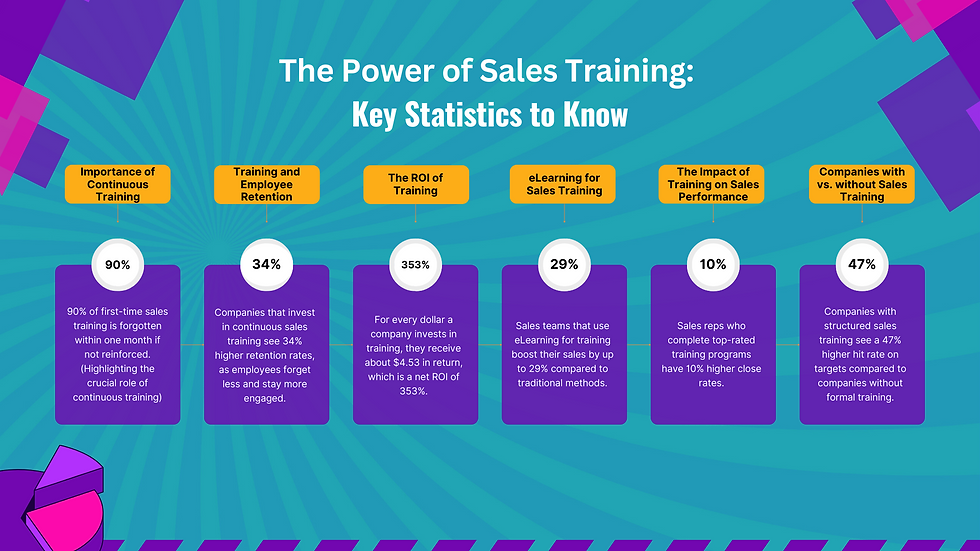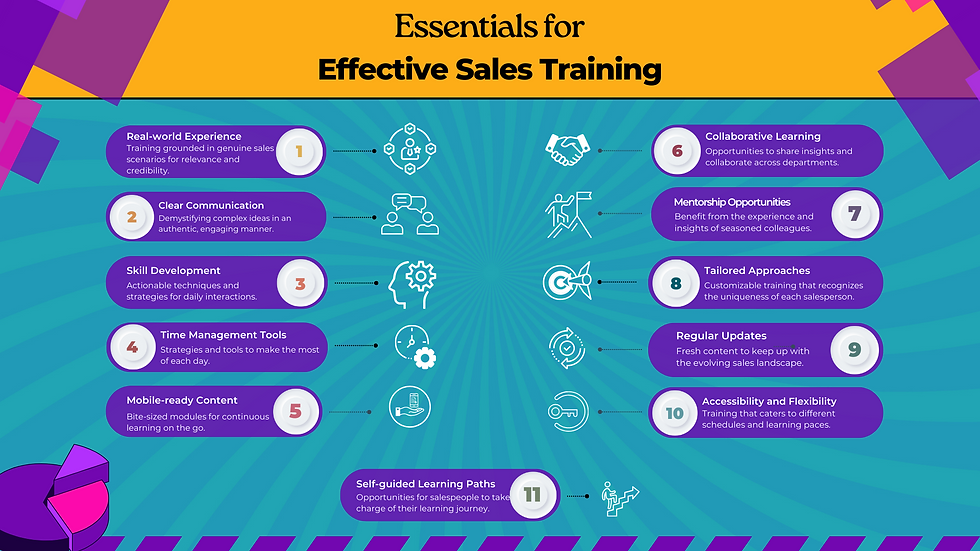The Ultimate Elearning Guide for Sales Training Excellence
- Neethi Kumar
- Sep 7, 2023
- 10 min read
Updated: Oct 3
You know, we’ve been reflecting on the tides of change in L&D, particularly sales training. Markets are evolving at a breakneck pace, and with it, the expectations from sales teams of Organisations. The old, rigid classroom training? It's feeling more like a relic each day.
Now, eLearning isn’t just the new kid on the block – it’s shaping up to be the vanguard of effective, modern training. And it's not just about digitizing content; it's about providing rich, relevant, and timely knowledge for our always-on-the-move sales teams.
As we navigate these waters, eLearning seems less like a trend and more like a compelling path forward. We’d love to hear your thoughts on this evolution.
What Does Sales Training Mean?
Sales training, at its core, is the process of developing sales professionals through education on product knowledge, sales skills, and customer relations. Here's why it's so crucial:
Understanding Customer Needs: Equips teams to delve deeper into customer pain points, offering solutions that resonate.
Building Relationships: Beyond a transaction, it's about fostering trust and ensuring long-term customer loyalty.
Effective Communication: Translating product features into tangible benefits that address customer needs.
Driving Growth: Ensures sales teams are proactive, adapting to market shifts, and always ahead of the curve.
Consistency: Standardizes sales approaches, ensuring the entire team is on the same page and moving cohesively.
Why Is Sales Training Essential?
Sales training is the foundation of enterprise growth. Beyond merely boosting revenue, it crafts strong customer bonds and positions a company a step ahead of competitors.
Here's why prioritizing it makes sound business sense:
Alignment: Having everyone on the sales team follow the same guidelines helps the company work smoothly and send out a clear message.
Revenue Drive: Good sales mean good revenue. Train your team well, and they’ll not only make more sales but also create lasting customer relationships.
Preparedness: Knowledge breeds confidence. When your sales team knows their stuff, they can confidently talk to clients and close deals.
Competitive Edge: Regular sales training gives your company an advantage. A trained sales team knows how to connect with customers and keep them loyal.
Skill Building: The world of sales is always changing. Training helps your team learn new ways to approach customers, close sales, and build strong relationships.
Employee Retention: Employees stick around when they feel skilled and valued. Good training makes them feel both, so they're less likely to leave.
Upholding Reputation: Your salespeople represent your company. When they’re trained well, they make the company look good.
Product Knowledge: Knowing the product inside out is key. It helps salespeople answer questions, address concerns, and make confident pitches.

The Limitations of Traditional Sales Training Methods
While traditional sales training methods have their merits, there are distinct limitations that businesses today must be aware of:
Time-Consuming: Traditional face-to-face training sessions often involve extensive preparation, schedule coordination, and, let's not forget, the actual training duration. This prolonged nature can eat into productive hours and affect overall sales performance.
Geographical Limitations: With sales teams often spread across various regions, cities, or even countries, organizing centralized training can pose logistical challenges. There’s the added cost and hassle of travel and accommodation when bringing everyone together.
Content Updates: Traditional training materials, whether they are printed manuals or presentations, don’t offer the flexibility of swift updates. This rigidity can lead to teams working with outdated information, potentially harming sales efforts.
Cost Implications: Arranging regular training workshops isn’t just about the session itself. Factor in venue rentals, material production, and potential guest trainers or speakers, and the expenses mount up. For some businesses, the cost-to-benefit ratio becomes hard to justify, especially when frequent training is required.
In light of these limitations, many businesses are now leaning towards more agile, modern solutions to ensure their sales teams are always at the top of their game.
Sales Training vs. Sales Enablement Training
Here’s how sales training and sales enablement training differ in focus and impact.
Aspect | Sales Training | Sales Enablement Training |
Focus | Building foundational sales skills | Providing ongoing tools & resources |
Approach | One-time or periodic sessions | Continuous learning & reinforcement |
Content | Selling techniques, objection handling | Product updates, real-time insights, CRM training |
Goal | Improve individual selling skills | Support sales teams for long-term success |
Delivery | Workshops, eLearning courses | On-demand content, AI coaching, playbooks |
What Do Salespeople Need from Sales Training?
Sales training aims to sharpen the skills of sales teams, making them more effective and adept at their roles. A robust sales training program isn't a one-size-fits-all solution.
Instead, it's tailor-made to fit the team's specific needs, ensuring every moment spent in training translates to real-world results. So, what defines a top-notch sales training initiative?

Real-world Experience: The theory is good, but it's the application in real-life sales situations that matters. Trainees should have opportunities to engage with scenarios that mirror challenges they'll face in the field.
Role-playing, case studies, and simulated sales encounters can bridge the gap between theory and practice, ensuring skills are not just learned, but also applied.
Relatable Content: The world of sales is intricate, but that doesn't mean training should be. The best programs decode the complexities, making every lesson relatable.
This includes using storytelling, practical examples, and relatable analogies to ensure that concepts aren't just understood, but are ready to be utilized.
Skill Development: It's one thing to know the playbook; it's another to play the game. Training should be hands-on, with emphasis on practicing techniques, handling objections, and closing sales. Interactive exercises and feedback mechanisms can help refine these vital skills.
Time Management Tools: In sales, every second counts. But it's not about working longer—it's about working smarter. Good training introduces tools and methodologies that help prioritize tasks, allocate resources, and ultimately, ensure the highest return on time invested.
Mobile-ready Content: In today's digital age, learning shouldn't be confined to a classroom. With the ubiquity of mobile devices, training content should be optimized for on-the-go access, allowing salespeople to brush up on techniques during commutes, between meetings, or whenever they find a spare moment.
Collaborative Learning: No salesperson is an island. By fostering a culture of shared knowledge—be it through group projects, discussion forums, or brainstorming sessions—training can tap into collective insights, offering a richer understanding than solo learning might achieve.
Mentorship Opportunities: The wisdom of those who've walked the path before is invaluable. Mentorship not only accelerates learning but also provides context, perspective, and the nuances that textbooks or modules might miss. A blend of formal mentorship programs and casual knowledge-sharing sessions can offer the best of both worlds.
Tailored Approaches: A one-size-fits-all approach can leave gaps in knowledge. Recognizing individual strengths, weaknesses, and learning styles can lead to a more personalized training experience, ensuring every participant gets exactly what they need to thrive.
Regular Updates: The art of selling is dynamic, shaped by evolving markets, technologies, and buyer behaviors. To stay ahead of the curve, training content should not be static. Regular revisions, based on industry trends and feedback, ensure relevance.
Accessibility and Flexibility: Whether early birds or night owls, every learner has their rhythm. Training platforms and modules should respect this diversity, offering content that's available round the clock, in formats that cater to varied learning preferences.
Self-guided Learning Paths: While a structured curriculum has its merits, autonomy in learning can be equally potent. Salespeople, entrusted with the freedom to explore topics of interest and delve deeper into areas they're passionate about, can often unearth insights that a rigid program might overlook.
Elearning Benefits for Sales Training
In the age of digital transformation, eLearning has firmly cemented its position as a key player in sales training. Benefits? Two words: cost-effectiveness and unmatched flexibility.
Transitioning to digital means you say goodbye to conventional training expenses like venue costs, physical resources, and hefty facilitator fees.
Furthermore, for our sales professionals always on the move, eLearning offers the luxury of learning on the go. Whenever they can carve out a moment, no matter their location, they can engage in training.
Types of Sales Training eLearning Supports
Product Knowledge: Through detailed modules, reps get a comprehensive understanding of product specifics, benefits, and unique selling points, preparing them for any query that might come their way.
Sales Skills: From initial contact to sealing the deal, eLearning modules focus on every step, refining and elevating the sales process.
CRM Training: Modern sales hinge on mastering CRM tools. With eLearning, sales teams can understand and use these platforms to their full potential.
Compliance Training: Doing things right is crucial. eLearning ensures that sales professionals know the legal and ethical ins and outs of their trade.
Soft Skills Training: Beyond product knowledge and strategy, skills like empathy and effective communication are invaluable in sales. eLearning offers targeted modules for these essential interpersonal skills.
Technical Sales Training: For those in tech-oriented sales, eLearning can offer detailed technical courses, ensuring sales reps have a profound understanding of the products they pitch.
eLearning's broad scope guarantees a well-rounded training experience, ensuring every sales rep has a toolkit equipped for every challenge and opportunity.
Sales Training Techniques L&D Professionals use in eLearning

Understanding training techniques is essential for L&D leaders. Let's dive into a week in the life of Anaya, a salesperson at NexaTech, to unpack these strategies:
Scenario-based Learning
What: Training rooted in real-life sales scenarios.
How: Anaya starts her week with an online module. She's presented with a challenging customer scenario, making choices based on her training to steer the conversation.
Experiential Learning
What: Hands-on, direct experience-based learning.
How: Today, Anaya and her team engage in an activity where they practice pitching a new product. They get to 'learn by doing,' which helps them remember and apply concepts better.
Blended Learning
How: Mid-week, Anaya attends a classroom session. It's led by an energetic trainer who uses an interactive deck to host quizzes and multimedia content. Anaya and her peers actively participate through their devices, making the session lively and engaging. She’s also able to access a digital learning aid post the session.
eLearning Gamification
What: Training modules structured as games to make learning engaging.
How: Anaya takes part in an online NexaTech sales challenge. As she identifies correct product features, she earns points, making the learning process fun and competitive.
Video-based Learning
What: Learning through visual and auditory content.
How: The next week sees Anaya exploring a series of instructional videos. These visually rich videos break down complex topics, making them easy to digest and retain.
Throughout the next week, Anaya also squeezes in moments for Microlearning: Quick, bite-sized lessons available on a mobile device that keep her updated without feeling overwhelmed.
This example of Anaya’s week at NexaTech demonstrates how Thinkdom seamlessly incorporates sales training techniques into the workweek. As you sculpt your training regimen, think about how these methods can enhance your team's skills, just as they did for Anaya.
How to Optimize Sales Training to Improve Performance?
Foundation first. Gauge where your team stands and identify the gaps. This isn’t just a survey; it’s about immersing yourself in their day-to-day. Consider spending a day in the life of a sales rep, understanding the hurdles and triumphs they face. The closer you are to their daily realities, the more tailored and effective your training can be.
Needs Assessment
Start with the basics. Understand where your team is now and where they need to be. This isn’t a tick-box exercise but a deep dive. Engage in conversations, hold focus groups, or even shadow a sales rep for a day. Understand their challenges firsthand. The more connected you are to their reality, the better you can tailor the training.
Data Analytics and Feedback
After the training, let's not play the guessing game. Utilize the data at your fingertips. Check for performance upticks, lead conversions, or even the time taken to close deals. But numbers are just part of the story. Chat with your team, get their feedback. An open-door policy here can work wonders.
Modern Learning Methodologies
Remember sitting through endless slide decks? Let's not put our teams through that. Check out modern techniques: interactive modules, real-life simulations, or bite-sized lessons. Let’s keep it fresh and engaging. Just picture Anaya from NexaTech, actively engaging with her training modules. That's the enthusiasm we're aiming for.
Key Performance Indicators (KPIs) to Measure Impact
KPIs, or Key Performance Indicators, are the pulse-check of any training initiative. Think of them as the vital signs that help diagnose the health of your sales training program. While training may feel impactful, it's these measurable outcomes that genuinely reflect whether it's bearing fruit or needs tweaking.

The table above showcases the difference in performance between companies that do the basics right (Good) and those that go the extra mile with their sales training (Great).
Now, the question is - why measure at all? The importance of gauging ROI (Return on Investment) in sales training can't be stressed enough. It's not just about how much you've spent, but what you've gained in return. Did the training translate to more closed deals? Improved customer relations? Boosted morale among salespeople?
ROI isn't merely about dollars and cents. It's about understanding the holistic value delivered by the training. It’s about ensuring that every penny spent on training doesn’t just evaporate but transforms into skills, techniques, and, eventually, sales.
In a nutshell, KPIs aren't just numbers on a dashboard. They’re your North Star, guiding your sales training initiatives, ensuring you're not just shooting in the dark but hitting the mark every time!
How Much Does Sales Training Cost?

The world of sales training can be both exhilarating and daunting. One of the pressing questions on many minds is, "How much will this investment set me back?"
Understanding the financial aspect of sales training is pivotal, not just for budgeting, but also for ensuring that you get the best value for your money.
Here’s a list of Factors Influencing the Cost:
Program Length and Depth: A comprehensive, multi-week program will typically cost more than a single-day workshop.
Customization: Tailored content to align with your specific industry and company goals might add to the expenses.
Training Format: Face-to-face training, eLearning modules, or a blended approach? Each has its own pricing structure.
Expertise of Trainers: Renowned industry experts might charge a premium for their insights and time.
Technological Integrations: Incorporating cutting-edge tech or platforms? These can add to the overall budget.
Location and Logistics: On-site training with accommodation or a simple online webinar? Location and logistics play a significant role in the cost.
While understanding the costs is crucial, it's just as essential to gauge the return on this investment. Think of the long-term benefits: improved sales performance, boosted morale, fewer errors, and stronger customer relationships.
When these gains outpace the initial training investment, it becomes clear that effective sales training isn't just a cost—it's an investment in future success.
Closing the Deal
Throughout our exploration, it's clear that the landscape of sales training is constantly evolving. The transformative potential of well-curated training programs can undoubtedly lead to increased revenues, and enhanced relationships with customers, and provide that competitive edge every business seeks.
Central to this evolution is the role of eLearning solutions. Its flexibility, accessibility, and adaptability make it not just an option but a necessity for forward-thinking companies.
As you chart the path for your sales teams, ensuring they are equipped with the best tools and methodologies will undoubtedly set them, and by extension your company, up for success.
And if you're looking for expertise, don't hesitate to check out Thinkdom. After all, we put this guide together for you and we've crafted sales training programs for some of the top companies globally. Let's collaborate and elevate your sales training to new heights!



